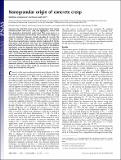Nanogranular origin of concrete creep
Author(s)
Vandamme, Matthieu; Ulm, Franz-Josef
DownloadVandamme-2009-Nanogranular origin.pdf (557.3Kb)
PUBLISHER_POLICY
Publisher Policy
Article is made available in accordance with the publisher's policy and may be subject to US copyright law. Please refer to the publisher's site for terms of use.
Terms of use
Metadata
Show full item recordAbstract
Concrete, the solid that forms at room temperature from mixing Portland cement with water, sand, and aggregates, suffers from time-dependent deformation under load. This creep occurs at a rate that deteriorates the durability and truncates the lifespan of concrete structures. However, despite decades of research, the origin of concrete creep remains unknown. Here, we measure the in situ creep behavior of calcium–silicate–hydrates (C–S–H), the nano-meter sized particles that form the fundamental building block of Portland cement concrete. We show that C–S–H exhibits a logarithmic creep that depends only on the packing of 3 structurally distinct but compositionally similar C–S–H forms: low density, high density, ultra-high density. We demonstrate that the creep rate (≈1/t) is likely due to the rearrangement of nanoscale particles around limit packing densities following the free-volume dynamics theory of granular physics. These findings could lead to a new basis for nanoengineering concrete materials and structures with minimal creep rates monitored by packing density distributions of nanoscale particles, and predicted by nanoscale creep measurements in some minute time, which are as exact as macroscopic creep tests carried out over years.
Date issued
2009-06Department
Massachusetts Institute of Technology. Department of Civil and Environmental EngineeringJournal
Proceedings of the National Academy of Sciences of the United States of America
Publisher
National Academy of Sciences
Citation
Vandamme, Matthieu, and Franz-Josef Ulm. “Nanogranular origin of concrete creep.” Proceedings of the National Academy of Sciences 106.26 (2009): 10552-10557. Print.
Version: Final published version
ISSN
0027-8424